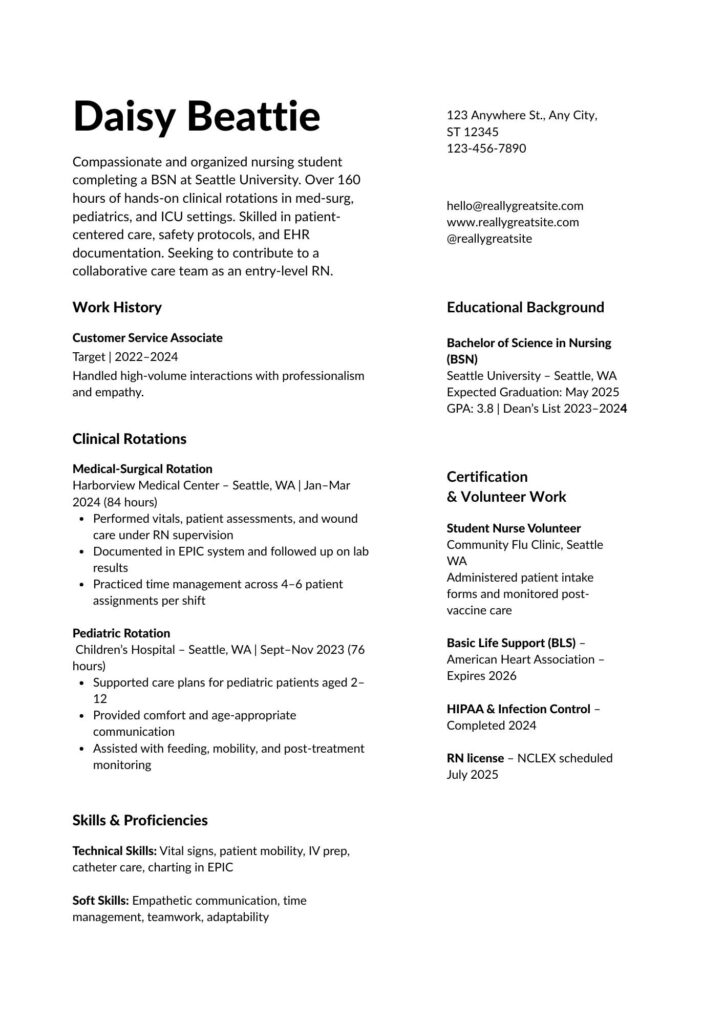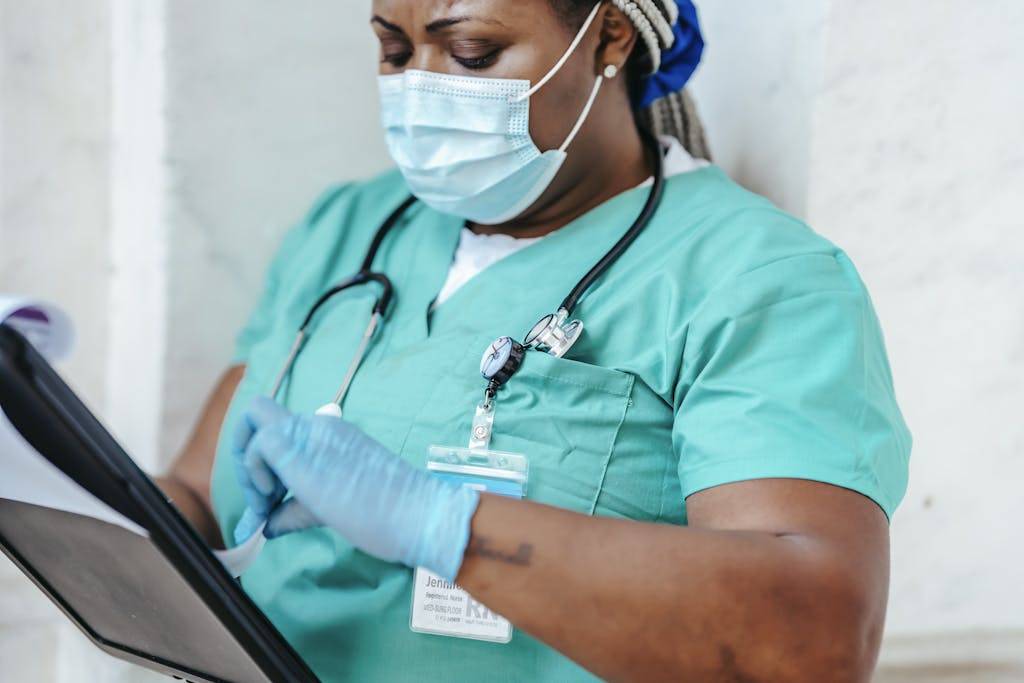Written by Sherry Lyons RN, Career Development Consultant | Reviewed by Harleen Kaur RN, MSN
Last Updated April 2025

When I was a nursing student, I remember staring at a blank resume template thinking, “What am I even supposed to put on here?” I hadn’t worked in a hospital, had no official job titles, and all I really had were my clinicals and coursework. If you’re feeling the same way — you’re not alone.
In this post, I’ll walk you through how to write a resume for nursing students that works even if you don’t have job experience yet. I’ll show you how to highlight your clinical rotations, choose the right nursing skills, and format everything so it looks clean, confident, and professional.
You’ll also get real resume examples for nursing students, tips for standing out with no work experience, and advice for building a strong nursing student resume with clinical experience. By the end, you’ll have everything you need to make your first nursing resume your strongest one yet.
Table of Contents
Why Nursing Students Need a Resume Before Graduation
You might think you don’t need a resume until after you pass the NCLEX or get your RN license — but building one now gives you a serious head start. Clinical rotations aren’t just academic — they’re a critical part of meeting licensure and education standards. In fact, the AACN reports that most programs require hundreds of hands-on hours before graduation.
Here’s why creating a nursing student resume with clinical experience is worth doing early:
- You’ll need it for internships, externships, and volunteer roles. Many hospitals and clinics ask for a resume when reviewing placement or shadowing applications — even if it’s informal.
- It helps you apply for scholarships, student leadership roles, or part-time jobs. Showing your commitment and experience (yes, your clinicals count!) makes you a stronger candidate.
- It builds your confidence. When you see your accomplishments laid out, you’ll start to recognize how much you’ve already learned and achieved.
- You’ll be ready to apply fast when opportunities pop up. Whether it’s a job fair, a surprise opening, or a professor offering a reference, having a resume on hand means you’re prepared.
Think of your resume as your professional snapshot — even as a student, it’s your chance to show you’re more than ready to start caring for others.
What to Include in a Nursing Student Resume (No Experience Needed)
Even if you haven’t worked in healthcare yet, you’ve already built a strong foundation through your education, clinical hours, and core skills. A great nursing student resume simply helps you organize what you’ve done in a way that’s professional and easy to read.
Here’s exactly what to include — and how to make each section count.
Contact Information (Professional & Clear)
Keep this part simple and professional:
- Full name (no nicknames)
- City and state (you don’t need your full address)
- Phone number
- Email address (use a professional email — ideally a school or Gmail account)
- Optional: LinkedIn profile or student nursing portfolio (if applicable)
Student Nurse Resume Objective (With Examples)
Your resume objective is your first impression — think of it as a quick introduction. For student nurses, this should highlight your current status, goals, and 2–3 strengths.
Good example:
Compassionate and detail-oriented final-year nursing student with 120+ hours of clinical rotations across med-surg and pediatrics. Passionate about patient-centered care and eager to contribute to a collaborative nursing team as an entry-level RN.
Tips:
- Keep it short (2–3 sentences max)
- Avoid generic phrases like “hard-working” or “team player” unless you back them up elsewhere
- Tailor it to the job or placement you’re applying for
List Your Education
As a student, your education is one of your biggest strengths — make it clear and easy to find.
Include:
- Degree title (e.g., “Bachelor of Science in Nursing”)
- School name and location
- Graduation date or “Expected [Month, Year]”
- GPA (only if 3.5 or above)
- Relevant coursework (especially if you haven’t done many clinicals yet)
- Honors, awards, or scholarships
Clinical Rotations You Did in Nursing School
This is the most important section on your nursing student resume with clinical experience — it’s where you show what you’ve done and learned in real patient care settings.
How to format it:
Medical-Surgical Clinical Rotation
Mercy Hospital – Boston, MA | Jan–Mar 2024 (90 hours)
- Provided bedside care for post-op patients under RN supervision
- Charted vital signs and patient observations using EPIC
- Collaborated with nurses and CNAs to monitor patient safety and fall risk
Tips:
- Use bullet points for responsibilities and outcomes
- Include the unit or specialty, hospital name, and total hours
- Highlight transferable nursing skills like patient communication, teamwork, charting, or medication handling
- Use action verbs (e.g., collaborated, assisted, performed, observed, documented)
💡 Even if it’s unpaid, your clinical work is real nursing experience — don’t downplay it.
Nursing Skills to List on Your Resume
Group your nursing skills to list on resume under subheadings for better readability. You can break them down into categories like:
Technical Skills
- Vital signs monitoring
- Wound care
- Catheter insertion/removal
- Electronic Health Records (e.g., EPIC, Cerner)
Soft Skills
- Empathetic communication
- Critical thinking
- Time management
- Team collaboration
🧠 Avoid random lists — show skills that match what you’ve practiced during clinicals.
Certifications and RN License (Even If Pending)
Include any certifications you’ve completed or are in progress — these show initiative and readiness.
Example:
- CPR – American Heart Association – Valid through 2026
- Basic Life Support (BLS) – Certified Jan 2024
- RN license – NCLEX scheduled for July 2025 (pending)
Optional Resume Sections for Nursing Students
If space allows, consider adding these:
- Volunteer experience – Especially if it’s health-related (e.g., vaccine clinics, care homes)
- Languages – Can be a plus in multicultural healthcare settings
- Nursing clubs or leadership roles – Show you’re active and engaged
- Course projects or simulations – Useful if you’re still early in your program
How to Write a Nursing Student Resume With Clinical Rotations
For student nurses, clinical rotations are your most important form of experience. They’re where you learn hands-on skills, interact with real patients, and start thinking like a nurse — so it’s crucial to present them clearly and professionally on your resume.
Even if you’ve only completed one or two rotations, listing them properly can help your nursing student resume stand out in a stack.
What to Include for Each Rotation
For every clinical rotation, be sure to include:
- Rotation type or unit (e.g., Pediatrics, Mental Health, Med-Surg)
- Hospital or facility name
- Location (city, state)
- Dates (Month-Year)
- Total hours completed (if available)
- 2–4 bullet points explaining what you did or observed
Format Example
Pediatric Clinical Rotation
Children’s Health Hospital – Austin, TX | Sept–Nov 2024 (96 hours)
- Supported RN with care plans and health education for children aged 2–12
- Performed head-to-toe assessments and monitored vitals under supervision
- Documented patient data using EPIC EHR system
- Practiced trauma-informed communication with patients and families
Tips for Writing Rotation Descriptions
- Use action verbs: “Assisted,” “Monitored,” “Observed,” “Collaborated,” “Documented”
- Focus on what you did, not just what you saw
- Highlight skills, tools, and types of patients or scenarios you encountered
- Connect rotations to real-world responsibilities — this helps employers see how ready you are
Bonus: Template You Can Copy
Here’s a mini-template you can use for every rotation:
[Unit or Specialty] Clinical Rotation
[Facility Name] – [City, State] | [Dates] ([Total Hours])
- [Action + task + setting]
- [Skill or tool used + outcome or learning]
- [Teamwork, communication, or safety-focused task]
Even if you only have one or two rotations completed, listing them well adds real, credible experience to your resume. For many student nurses, these bullets are what employers look at first — so it’s worth taking the time to write them clearly.
Nursing Student Resume Tips
One of the biggest concerns nursing students have is, “What do I put on my resume if I’ve never had a nursing job?” The truth is — you don’t need paid experience to create a strong, professional resume. Your clinical rotations, education, and transferable skills already show that you’re capable and ready to grow.
Here’s how to build confidence on paper, even if this is your first step into the workforce.
Lead with What You Do Have
- Start your resume with your education and clinical experiences — these are your strongest assets.
- Your nursing skills, coursework, and certifications already show commitment and competence.
- If you’ve done any health-related volunteering (vaccine drives, care homes, clinics), include it — it counts!
Replace Work Experience with Relevant Sections
If you don’t have a job history to include, use these sections to show value:
- Clinical Rotations — formatted as real-world experience (covered in the last section)
- Volunteer Work — especially if it’s patient-focused or service-based
- Relevant Coursework or Simulations — pick 1–2 projects where you demonstrated nursing skills
- Academic Projects or Presentations — these show research, communication, and organization
🧠 Tip: You can even label a section “Practical Experience” if you want to combine your clinical and volunteer efforts.
Example: No-Work-Experience Resume Snippet
Course Simulation: Patient Safety & Communication
University Simulation Lab – April 2024
- Participated in a multi-role hospital simulation focused on fall-risk management
- Practiced SBAR communication during nurse-to-physician handoff scenarios
- Applied infection control protocols using PPE and isolation procedures
Use Your Soft Skills — but Back Them Up
Many student resumes say “strong communicator” or “hard worker” — but hiring managers want proof. Show your soft skills through your clinical actions.
Instead of this:
“Excellent communication skills”
Say this:
“Built rapport with pediatric patients and their families to reduce anxiety during treatments”t
If you’re applying with no work history, the key is to frame what you’ve already done — not apologize for what you haven’t. With strong clinical rotation examples, a focused skills section, and a clear objective, your resume can show potential employers that you’re ready to hit the ground running.
Formatting an Entry-Level Nursing Resume for ATS & Recruiters
Even with the right content, your nursing student resume needs to be formatted correctly to make an impact — and to get through Applicant Tracking Systems (ATS), which scan resumes before a human ever sees them.
The good news? You don’t need fancy designs. In fact, the best resumes are clean, simple, and easy to read for both humans and software.
Stick to a Clear, Modern Layout
- Use standard fonts like Arial, Calibri, or Helvetica — 10 to 12 pt
- Keep your resume to one page (unless you’ve had extensive clinicals or relevant volunteer experience)
- Use bold and capital letters for section headings, not colors or graphic elements
- Maintain consistent spacing and formatting — it makes you look polished
🧠 Avoid text boxes, columns, tables, or graphics — they confuse ATS software
Suggested Resume Section Order
Here’s a layout that works well for most nursing students:
- Contact Information
- Resume Objective
- Education
- Clinical Rotations
- Skills
- Certifications & Licensure
- Optional: Volunteer Work, Languages, Projects
Save and Submit the Right Way
- Save your resume as a PDF unless the job listing specifically asks for a Word doc
- Name the file professionally:
Firstname_Lastname_Resume.pdf - Double-check that formatting still looks clean in both PDF and preview modes
A clean format doesn’t just help with scanning — it shows that you’re organized, professional, and ready to be part of a clinical team. It’s one of the easiest ways to give your resume a strong first impression.
Common Mistakes to Avoid on a Nursing Student Resume
It’s easy to second-guess your resume — especially if you’re writing one for the first time. The good news? Most resume mistakes are completely avoidable with a little guidance. Here are the most common issues I see with nursing student resumes, and how to fix them.
Mistake #1: Underselling Your Clinical Rotations
Your clinical experience is the core of your resume — but many students either skip this section or write it too vaguely.
Fix it: List each rotation clearly. Include the unit, facility, dates, total hours, and 2–4 detailed bullet points describing what you did.
Mistake #2: Listing Skills Without Context
A long list of random skills like “communication,” “empathy,” and “teamwork” doesn’t mean much on its own.
Fix it: Show your nursing skills to list on resume in action — especially in your clinical rotation bullets or volunteer experience.
Mistake #3: Using a Generic Objective
Many student resumes start with something like “Looking for a job to gain experience…” — which says very little.
Fix it: Make your resume objective specific to nursing, your clinical strengths, and your career goals. Make it about what you bring, not just what you want.
Mistake #4: Skipping Certifications or Licensure Info
Even if you don’t have your RN license yet, it’s important to show you’re on track.
Fix it: Include certification names, issuing organizations, and expiration dates. If you’ve scheduled the NCLEX, say so (e.g., “NCLEX scheduled for July 2025”).
Mistake #5: Overdesigning Your Resume
Bright colors, fancy fonts, or resume templates from Canva might look pretty, but they often break in ATS systems.
Fix it: Use a clean, ATS-friendly template — one column, no graphics, no tables. Focus on clarity, not creativity.
Mistake #6: Sending the Same Resume Everywhere
Generic resumes rarely stand out — especially in competitive healthcare environments.
Fix it: Customize your resume for the job or internship you’re applying for. Use keywords from the job posting. Emphasize the most relevant clinical experience.
Avoiding these simple mistakes will instantly boost your resume’s quality and help you come across as capable, detail-oriented, and ready to step into your first nursing role.
Nursing Student Resume Example (Clinical Experience Focused)
Seeing how everything comes together can make it much easier to write your own. Below is a sample nursing student resume with clinical experience, tailored for a final-year student applying to their first entry-level role or internship.
This example includes all the key sections we’ve covered so far — from clinical rotations and nursing skills to formatting and structure.

FAQs About Nursing Student Resumes
What should a nursing student put on a resume?
A nursing student resume should include your current education and expected graduation date, clinical rotations with facility names and completed hours, relevant nursing skills (both technical and soft), any certifications such as BLS or HIPAA, and a short resume objective tailored to your goals.
You can also include optional sections like volunteer experience, languages spoken, or involvement in nursing-related clubs and organizations. Even without formal job experience, clinicals and coursework show you’re prepared to enter the field.
How do you write a nursing student resume with no experience?
If you don’t have any healthcare work experience yet, the best approach is to focus on your clinicals, education, and transferable skills. Start with a strong objective that reflects your personality and goals.
Include your completed clinical rotations and hours, highlight your soft skills, and list any volunteer work or relevant coursework you’ve completed.
You can also include nursing simulations or projects from school to show practical application of your knowledge. Label your experience section as “Clinical Experience” or “Practical Experience” to emphasize hands-on learning.
How do I list clinical rotations on a nursing resume?
To list clinical rotations on a nursing student resume, start with the rotation type, followed by the facility name, city and state, and the dates you completed the rotation along with the total hours.
Beneath that, add a few short descriptions of what you did during the rotation — including the skills you used, patient types you worked with, and any tools or systems like EPIC you used.
Focus on action verbs and show how your experience in clinicals reflects real nursing practice.
Should I use a resume template as a nursing student?
Yes, using a clean and professional resume template can make your resume easier to read and help it pass through applicant tracking systems. Stick to a single-column format using simple fonts like Arial or Calibri.
Avoid tables, images, or graphics that could break when scanned by software. Save your resume as a PDF unless the job posting asks for a different format. A simple, well-organized nursing resume template helps you present yourself clearly and professionally.
Should I include non-healthcare jobs on my nursing student resume?
You can absolutely include non-healthcare jobs if they demonstrate transferable skills that are relevant to nursing.
Roles in retail, customer service, childcare, or hospitality can show your strengths in communication, multitasking, empathy, time management, and working under pressure. Just keep the descriptions focused on the soft skills or responsibilities that relate to nursing practice.
Should I list my expected RN license date on my resume?
Yes. If you haven’t taken the NCLEX yet, it’s helpful to let employers know you’re on track. You can simply write something like “RN license – NCLEX scheduled for July 2025.” This shows initiative and tells hiring managers you’re planning ahead and serious about your licensure.
Final Checklist: Submit Your Nursing Student Resume With Confidence
Before you hit send, take a minute to make sure everything’s in place:
- Is your contact info professional and complete?
- Did you include an objective that reflects your goals as a student nurse?
- Are your clinical rotations listed clearly with hours and bullet points?
- Have you grouped your nursing skills in a way that’s easy to scan?
- Did you mention any certifications, like BLS or HIPAA?
- Is the formatting clean, mobile-friendly, and saved as a PDF?
If you can check all of the above, you’re ready to send off a resume that shows confidence, clarity, and nursing potential.
If you’re approaching graduation, check out our guide on how to write a nursing graduate resume with no experience to level up your next application.
You’re Closer Than You Think
The demand for nurses continues to grow — with over 170,000 new RN roles projected in the next decade, it’s the perfect time to start preparing your resume, even before graduation. Whether you’re applying for your first internship, a nurse externship, or just building your portfolio early, the time and effort you invest now will set you apart later.
Start with the resume you’ve built here. Tailor it to each opportunity, stay confident in your clinical experience, and remember: even without a job title, you’ve already stepped into the role of a nurse.
Once your resume’s ready, the next step is crafting a strong cover letter — here’s how to write a nursing graduate cover letter that gets noticed.


